So far we learned about which courses in relation to the wind exist, how we find them and how we trim the sails for it. We know how to head up and to bear away. We can sail up and down on one side of the wind rose. But how do we get to the other side of the wind?
One possibility to do that is tacking. We go through the wind with the bow and change tack. The boats heading in relation to the wind is called starboard tack or port tack. That depends from which side the wind comes. That is always called the … ? Right, the windward side. When the wind is on starboard side the boat sails on starboard tack, when wind is on port side the boat sails on port tack.
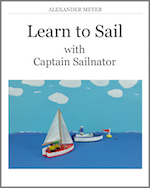 This online sailing course has also been published as ebook and paperback. For more information click here!
This online sailing course has also been published as ebook and paperback. For more information click here!
You can download the Ebook for example at:
iTunes UK & iTunes US | iBooks for iPad and Mac
Amazon.com & Amazon.co.uk | Kindle-Edition
Google Play | for Android
The paperback is available for example at:
Amazon.com | Amazon.co.uk
We tack from the course close-hauled to close-hauled on the other side of the wind rose. Shortly after the bow passes the middle, (which is called “In irons”, should we stop there), the sails change to the new leeward side of the boat. So if we sail on beam reach, we first have to head up to close-hauled to start tacking. And when the bow has gone through the wind we have to be careful that we do not bear away too far.
So first we have to look for close-hauled. How did that work again … ? Right. We haul the sails, head up by pushing the tiller, till the jib luffs and bear away till the jib fills again. We stay on course for a little while to get up to speed, as some momentum is needed to tack.
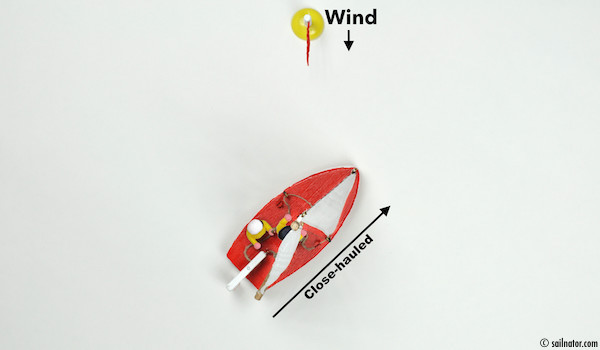
Figure 37: From course close-hauled …
If we want to go through the wind with the bow, what do we have to do before tacking? Head up or bear away … ? Right, head up. We push the tiller away of us, but not too strongly. The rudder must not stand too far askew, as it would act as a brake. (Figure 38)
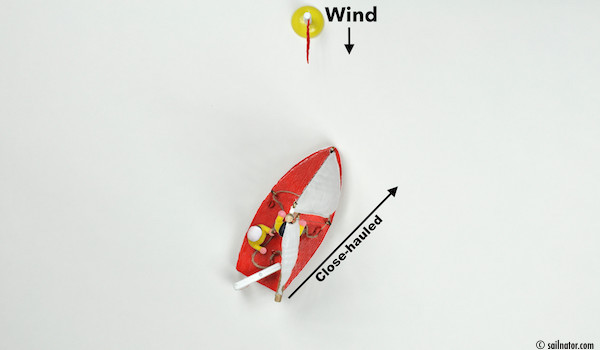
Figure 38: … head up by pushing the tiller.
Now the bow turns through the wind, the jib luffs, we keep on pushing the tiller and keep our head below the boom, because it will come over in a next moment. (Figure 39) Where does the helmsman sit … ? Right, he always sits leeward, opposite the mainsail. So when the boom changes from one side to the other when tacking, the helmsman has to change to the opposite side. You will find the right moment for this in time. (Figure 40)
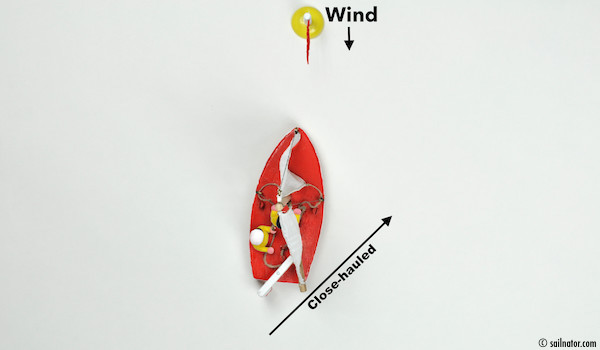
Figure 39: The sails luff and the bow goes through the wind. The tiller has still to be pushed away.
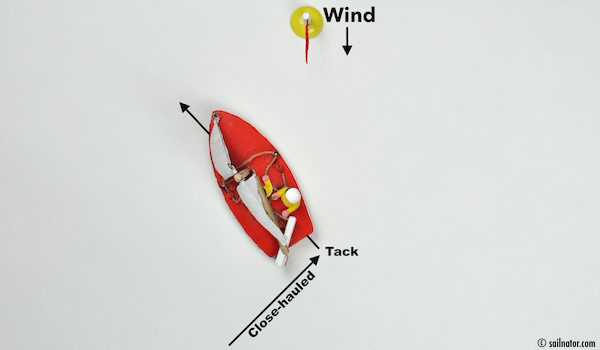
Figure 40: The boom is coming over to the other side. The helmsman turns over too and commands: “Release sheet!”
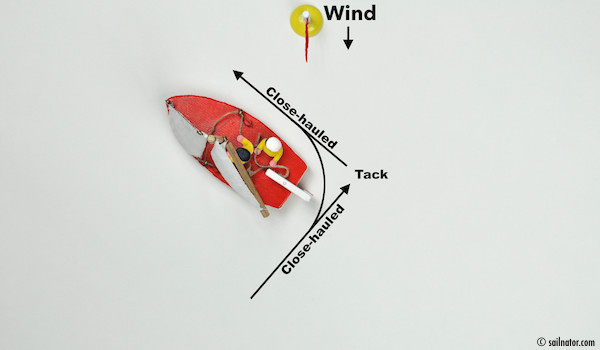
Figure 41: Stop bearing away by putting the tiller in the middle of the boat. Command: “Sailing close-hauled!”
It is very important that the helmsman faces the bow when changing the side in order to keep an eye on the sails. The face looks to the front the entire time and the back points to the stern. Let’s say we sit on port side, that is which tack … ? Right, the boat sails on port tack. Then we have the tiller in our backhand, which is the right hand, and the mainsheet in our front hand, which is the left hand.
In this case the procedure of tacking is as follows: We push the tiller away from us and turn face and body to the front. The right hand is now behind our back on the tiller. The mainsheet is still in our left hand.
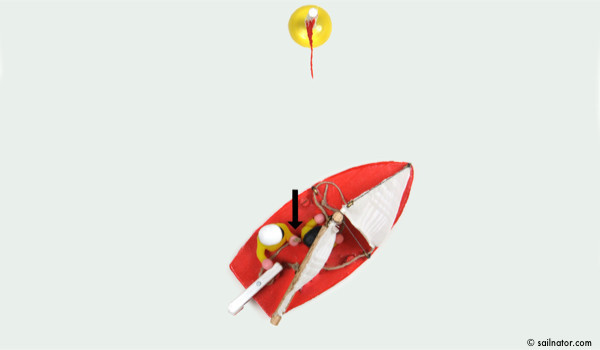
Figure 42: The helmsman sits windward on port side. He holds the tiller in the right hand and the mainsheet in the left hand. (Pointed by the arrow.)
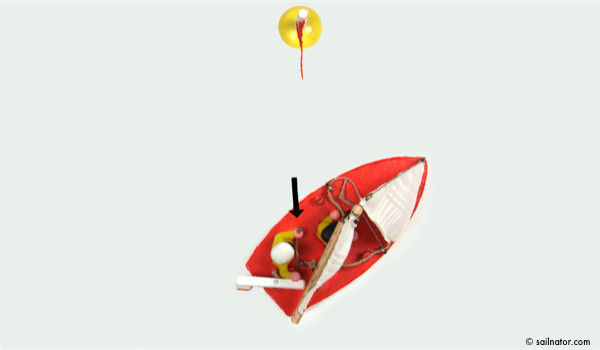
Figure 43: He pushes the tiller away from him and moves to the middle of the boat with the face to the front.
The bow now turns through the wind. The boom moves from starboard to port side. We dive through under the swinging boom with our face to the bow by watching the sails and with the back to the stern. For a short moment we stay in the middle of the boat until the boom reaches port side. Now we move the tiller to the middle of the boat behind our back.
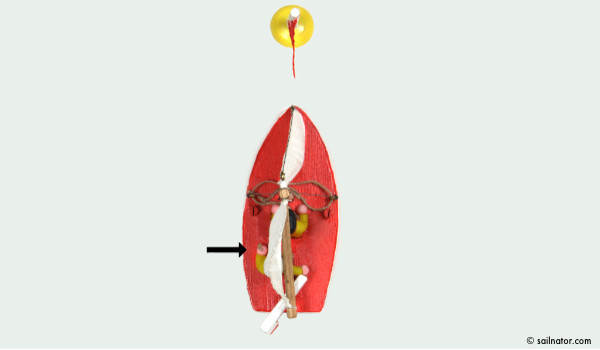
Figure 44: The bow turns through the wind and the helmsman dives through under the swerving boom.
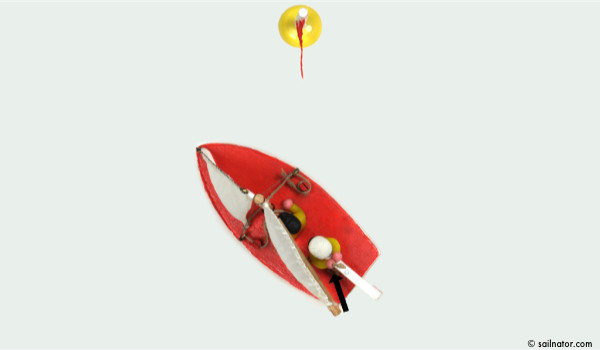
Figure 45: As soon as the boom reaches port side the helmsman moves the tiller to the middle of the boat. He now passes the tiller from the right to the left hand behind his back.
Now we hand over the tiller to the left hand behind our back, release the right hand and seat ourselves on starboard. Arriving there we take the mainsheet from the tiller with the right hand and keep on sailing on course close-hauled.
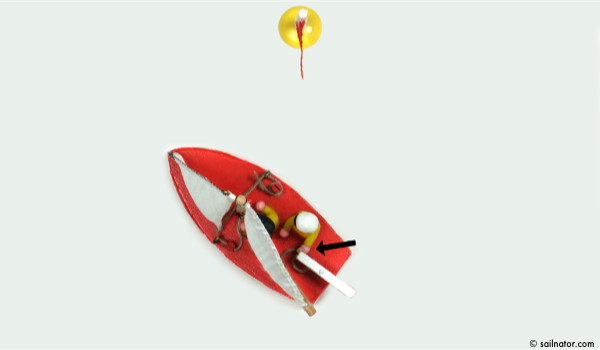
Figure 46: The helmsman sits himself windward on starboard with tiller and mainsheet in his left hand …
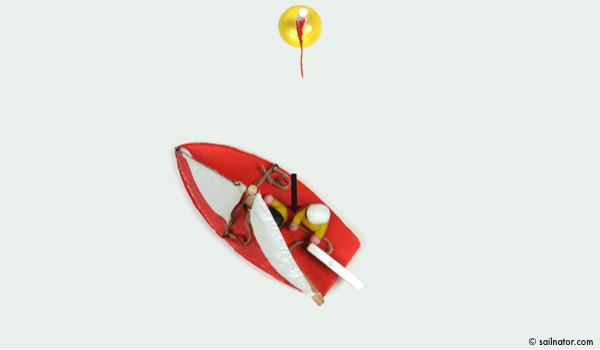
Figure 47: … and lastly passes the mainsheet from the left hand to the right hand.
That sounds complicated but is very easy and is done in a few moments. Have a look at figures 42 to 47 and carefully follow the operation step by step in your mind.
It is very important not to put the tiller in the middle before the bow has gone through the wind and the boom has reached the other side. If we do it too early the boat might get stuck in the wind without any manoeuvrability. That is called being in irons.
What does the crew do with the jib when tacking? As we have learned before the jib starts luffing as soon as we leave the course close-hauled and head up too far. Just in the moment when the bow has gone through the wind the jib fills with wind from the other side. This is the sign that the jib has to be pulled to the other side. To do this, the previously-used jib sheet hast to be released and the new one has to be hauled. Then it can be held by hand or we cleat it.
The jib should be pulled to the other side relatively quickly. The reason behind this is that when it fills with wind properly, it gets even harder to trim it afterwards. The bigger the boat is, the bigger the wind pressure in the sails is. On yachts the sheets are operated by so called winches that make it much easier to haul the sheets.
But if the jib is pulled to the other side too early, before the bow has gone through the wind, there will be backwind in the jib, coming from the side the boat is tacking towards. In the best case it simply slows down the manoeuvre, in the worst case the wind blows the boat back in irons.
The commands for the manoeuvre are:
The helmsman calls:
“Ready to tack!”
The crew responds: “Ready!”
“Ready!” may only be said, when the crew is actually ready for action and the sheets are clear. Most importantly there has to be space windwards for the boat to tack into. There must be no boat or other obstacle within that area. The helmsman has to count on that he really can start tacking when the crew says they are: “Ready!”
That he is now tacking he announces with “Tacking!”, “Helm’s alee!” or “Hard alee!” and calls the command: “Release (jib) sheet!” when the jib has to be pulled to the other side. The last command is: “Trim sails for close-hauled!” because tacking is from course close-hauled to clause-hauled on the other side of the wind’s direction. The point is not to bear away too much, unless intended. How would be the next command in that case … ? Right: “Ease sheets for beam reach!”
Watch my stop motion video about tacking with Jenny and Tom →
That was tacking. In the next chapter I explain how to reach a goal that is exactly in the direction of the wind by sailboat.
← Last chapter | Next chapter →
All chapters: Technical Terms | The theory behind sailing |Close-hauled | Beam reach | Broad reach | Sailing downwind | Tacking | Beating | Quick-turn | Sailing up head to wind | Man overboard | Jibing | Heaving-to | Leaving the dock | Berthing | Rules of the road 1 | Rules of the road 2 | Rules of the road 3 | Reefing | Capsizing